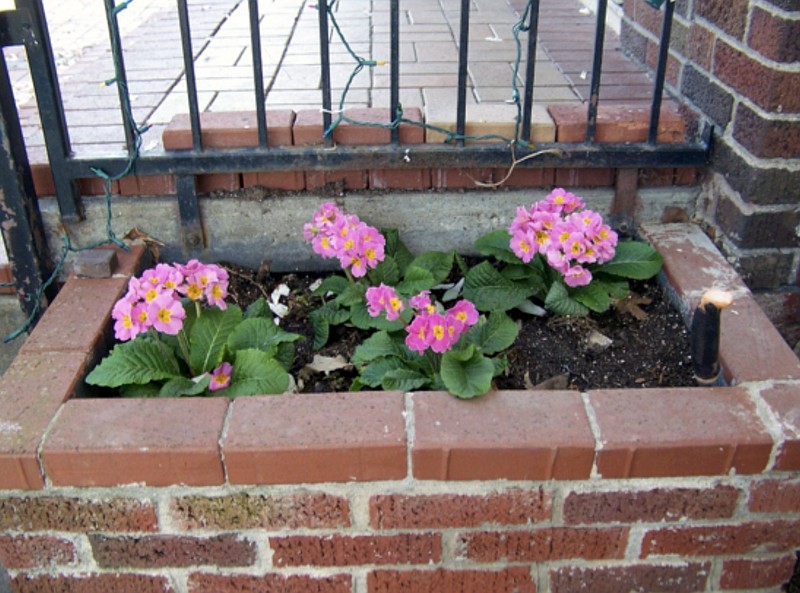Q: I planted these hardy primrose around March 15 (see photo), and they have been quite nice through this chilly weather. I checked when purchasing and didn't see many new flower stalks coming. I had thought maybe more would form, still none, but they are now getting some new leaves in the center. Are they likely get any new flowers?
A: Hardy primrose is a lovely early spring flower, but not likely to make further blossoms after the initial flush wanes. It is a long day plant, meaning that as the days increase it is stimulated to initiate flowers. The problem is it tolerates warm/hot weather and thus its vigor will decline as the spring progresses. If it doesn't have vigorous growth it won't have the energy to put out new flowers. You could get lucky if the spring is very mild into May. Thanks to state floriculture specialist Dave Trinklein for his help with this question.
Q: I have a blue spruce which has some lower branches on one side that have dropped the needles. Will those bare branches come back? And how can I stop it from spreading?
A: I had a nice blue spruce that gradually had foliage deteriorate from the bottom up, and by the time I dealt with it, it was too affected to leave. Taking action this year would be good. The problem could be from an insect or a fungus or both. Fortunately, both can be corrected with foliar sprays applied at the same time. Mine was afflicted by both. First, I encourage you to clean out any of the dead branches where there is no green growth - they won't recover. That will improve the looks some.
You may have bagworms (for complete info see: extension2.missouri.edu/g7250). When you clean up those dead lower branches, you may see some of them with lower green growth. If you do, you need to treat for them. It's a fungal problem you likely can't or won't be able to diagnose. I think it is easier to just treat the tree regardless. Both problems can be fixed with a foliar spray at these times: end of May (Memorial Day weekend is a good time) and two or three weeks later.
For the bagworm, a good natural product is "Captain Jack's Deadbug Brew," but there are other products mentioned in the publication. For the fungus, you could use any of these: Daconil Broad Spectrum fungicide (active ingredient chlorothanonil), Spectracide Immunox (active ingredient mycobutanil) or copper sulfate. For the spray solution also include some spreader sticker at that label rate. Otherwise the spray will tend to easily run off those waxy spruce needles. Spray both this year and next year.
Q: I was interested in putting down some pre-emergent herbicide like Preen, but I was going to apply mulch. Should I put it down on the ground or on top of the mulch?
A: Well that depends. It would suppress weed seed germination under the mulch, but seeds that land on top of the seeds would germinate. If it is high quality mulch that is free of weed seeds, it might give some benefit. If the mulch is put on at a typical depth (an inch or two), then the mulch would suppress weed seed germination, so it is questionable if it's beneficial.
If the mulch is in place for some time and one is changing seasons, going into the fall or coming into the spring, then putting it on top of the mulch would prevent the weeds from germinating during that typical cool and moist season. That seems the most typical use of a product like this when using with mulch.
Q: I've had trouble with some vegetables I seed, like peas and sweet corn. They get these little worms in the seed and hardly any come up. I checked online and it seems to match something called seedcorn maggots. How do I control these? I live out in the country with pastures around me.
A: You did a good job of finding the likely culprit. For detailed information, University of Kentucky has a good publication on them (visit: entomology.ca.uky.edu/ef309). The seedcorn maggot is mainly an early season pest that tends to cause greater losses in fields with abundant decaying organic matter, such as manure and green plant residues, and during years when the early growing season is cool and damp. They are attracted to freshly tilled ground.
To control them, the only common home garden vegetable insecticide I could find labeled for legumes (peas and beans) and listing seedcorn maggots was the new formulation of Sevin (active ingredient zeta cypermethrin). Mix it at the label rate and spray a band 2-3 inches wide over the row you just seeded. Do this immediately after seeding as this controls the adult flies that show up right away.

